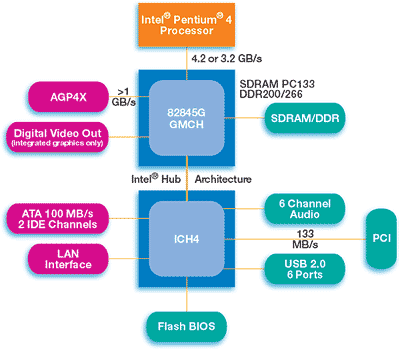
|
Traditionally, Intel chipsets have always been the fastest and most stable for Intel processors; just
consider the venerable i440BX, i815E or even the i850E.
|
|
|
|
Home >
Reviews >
Motherboards >
Various |
|
|
The i845E, i845G and the new ICH4
In the quickest terms the i845E chipset is basically the
i845D validated to run at 133 MHz (533 MHz). Other then that, there are no
architectural differences between the two Memory Controller Hubs (MCH a.k.a.
Northbridge). The i845E chipset still only officially supports PC1600/2100
DDR memory.
Even though
many i845E boards have three DIMM slots, the i845E can only take advantage of a maximum
of four banks of memory. Basically, if the motherboard has three DIMM slots
but you're using two double sided sticks of memory, the the third free slot
will not work - even if you install memory into it. This limitation is very
similar to the one found on the original i815 line of chipsets.

The i845E
chipset is also limited in support of graphics cards to 4x AGP videocards
which run on 1.5V. To try and ensure there are no mix ups with 3.3V videocards, all Intel i845E chipset
based motherboards have the 1.5V AGP lock.
The i845G Chipset:
The i845G is very similar to the i845E except that it has
an integrated video controller (Intel Extreme Graphics). Officially, other then the on board video
controller, the i845G and i845E are technically identical.
Unofficially, the i845G has a memory divider that allows
for PC2700 (DDR333) use, and as you'll see in the upcoming benchmarks this extra
bandwidth can come in very handy. At stock speeds, i845G based motherboards are
often faster then their i845E counterparts.
The i845G chipset was not able to escape the four bank memory
limitation that all the other i845 chipsets have unfortunately.

Even though Intel Extreme Graphics controller
is based on a shared memory architecture (the controller takes either 1MB or 8MB
of system memory), it's still a big step in the right direction for
on board video, and actually quite useful.
The Intel Extreme Graphics core is no where close in terms of 3D performance
to a GeForce4 Ti4600, but it's a lot better then all the other
on board solutions out there right now.
3D performance is about the same as
a GeForce2 MX200, and while that may sound bad, in terms of integrated
graphics that is pretty damn good. Intel knows though, if you're going to
be using the integrated graphics core you probably won't be gaming, and the
real strength of the Intel Extreme Graphics core lies in its 2D image quality.
Text is very well defined and readable, pictures and other still imagery are quite
vibrant even at resolutions of 1280x1024!
For those who want to game with their i845G based
motherboard, never fear. All i845G based boards should have support for a 4x
1.5V AGP slot, though but not all boards will have it physically
installed.
The new ICH4
Southbridge:
GeForce2 GTS, Voodoo5 5500 and
Intel ICH2, what do these three things have in common? They're all about two
years old and when you think about it, in an industry where three and six
month product cycles are a long time, it's amazing that the ICH2 has been with us for
so long. Finally with the release of the i845E/i845G comes a new I/O hub, the
ICH4.
Since Intel never endorsed the Ultra/133 IDE standard
rather focusing their energies on Serial ATA, the ICH4 can only handle HDD's up
to Ultra/100 (Maxtor Ultra/133 drives will default to
Ultra 100 when used with the ICH4).
Also integrated into the ICH4 southbridge is an 5.1 AC'97 codec and a
software 10/100 LAN controller. The biggest upgrade the ICH4 has over the ICH2
is onboard USB 2.0. With a total of 6 USB 2.0 ports you'd be
pretty hard pressed to use them
all.
|
